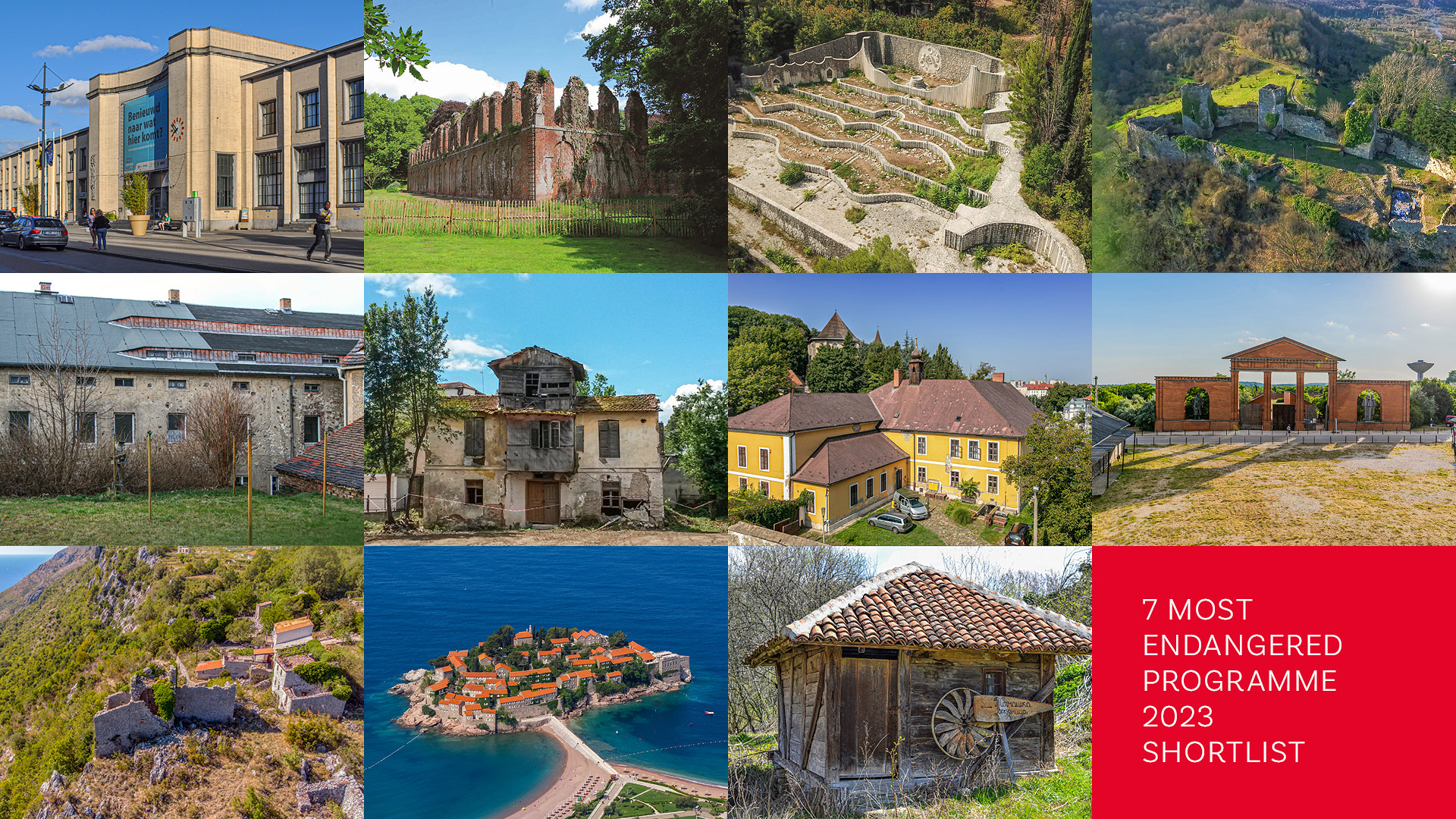
The 11 shortlisted heritage sites for the 7 Most Endangered Programme 2023 have been announced. This programme is part of a civil society campaign to save Europe’s threatened cultural heritage sites by raising awareness, preparing independent assessments and proposing recommendations for action. It also provides a grant of €10,000 per listed site to assist in implementing an agreed activity that will contribute to saving the threatened site.
The campaign, which this year celebrates its 10th anniversary, is run annually by Europa Nostra in partnership with the European Investment Bank Institute and with the support of the Creative Europe programme of the European Union.
The 11 monuments and heritage sites shortlisted as the most endangered in Europe for 2023 are:
–Kortrijk Railway Station, Kortrijk, BELGIUM
–Domain and Royal Museum of Mariemont, Morlanwelz, BELGIUM
–Partisan Memorial Cemetery, Mostar, BOSNIA AND HERZEGOVINA
–Tchakvinji Fortress, Zugdidi, GEORGIA
–Sisters’ House Ensemble, former Moravian settlement in Kleinwelka, GERMANY
–Mansion (“Konaki”) of Gidas, Alexandreia, GREECE
–Herman Ottó Museum, Miskolc, HUNGARY
–Memento Park, Budapest, HUNGARY
–Cultural Landscape of Paštrovska Gora, MONTENEGRO
–Cultural Landscape of Sveti Stefan, Paštrovići, MONTENEGRO
–Watermills of Bistrica, Petrovac na Mlavi, SERBIA
The selection of the shortlisted sites was made on the basis of the outstanding heritage significance and cultural value of each of the sites as well as on the basis of the serious danger that they are facing today. The level of engagement of local communities and the commitment of public and private stakeholders to saving these sites were considered as crucial added values. Another selection criterion was the potential of these sites to act as a catalyst for sustainable development and as a tool for promoting peace and dialogue within their localities and wider regions.
These sites were shortlisted by an international Advisory Panel, comprising experts in history, archaeology, architecture, conservation, project analysis and finance. Nominations for the 7 Most Endangered Programme 2023 were submitted by member organisations, associate organisations or individual members of Europa Nostra from all over Europe as well as by members of the European Heritage Alliance.
The final list of the 7 Most Endangered heritage sites in Europe for 2023 will be unveiled in April.
Religious heritage sites
Among the shortlisted sites this year there are four religious heritage places: Partisan Memorial Cemetery of Mostar in Bosnia and Herzegovina; the Sisters’ House Ensemble in Germany; the Cultural Landscape of Paštrovska Gora and the Cultural Landscape of Sveti Stefan, both in Montenegro.
Partisan Memorial Cemetery, Mostar, Bosnia and Herzegovina
Built in 1965 in the town of Mostar, the Partisan Memorial Cemetery is one of the largest anti-fascist monuments in the Balkans. It features some 700 individual tombstones as grave markers of freedom fighters from the Yugoslav Partisan movement, being part of a series of monuments and sites built in the region in memory of the partisans who died during World War II. The cemetery was designed by the famous Yugoslav architect Bogdan Bogdanović.
Although much damaged during the war in 1992-1995, the monument suffered further damage in times of peace. After the war, the first conservation and restoration works on the cemetery were done in 2005.

Partisan Memorial Cemetery, Mostar, BOSNIA AND HERZEGOVINA © Urban house IDEAA (2022)
Sisters’ House Ensemble, former Moravian settlement in Kleinwelka, Germany
Built in the mid-18th century, the Sisters’ House Ensemble (“Schwesternhaus”) is located in Kleinwelka, a former Moravian settlement in Saxony, Germany. The sisters lived together, set up an education system, ensured health care for themselves and locals, and were active in the wider community of Kleinwelka and the rural area beyond.
The Moravian settlement began to decline by the 20th century. Tenants started moving out due to low housing standards. Since then, the abandoned ensemble of buildings has been hardly used and has fallen into decay.

Sisters’ House Ensemble, former Moravian settlement in Kleinwelka, GERMANY. Source C. Kumpe, Förderverein Schwesternhäuser e.V. (2020)
Cultural Landscape of Paštrovska Gora, Montenegro
Paštrovska Gora is located in south-central Montenegro. It consists of many small villages, which feature archaeological remains and historical buildings from many cultures from various phases of history, including the Ilyrian, Medieval, Venetian and Austro-Hungarian periods. The Monastery of Duljevo, dated to the 12th century, the Church of Holy Lady, dated to the 14th century, and the Kosmač Fort, built in the 19th century, are among the most important heritage sites in the area. All these monuments are surrounded by outstanding natural heritage, combining the proximity with the coast, a forest region, river streams and waterfalls.

Cultural Landscape of Paštrovska Gora, MONTENEGRO. Source Blazo Kazanegra
Cultural Landscape of Sveti Stefan, Montenegro
Sveti Stefan is a 15th-century fortified town, built on an islet, which was the cultural and administrative heart of the Paštrovići region. It includes four churches, several stone houses, streets, lanes, squares and gardens, and is connected by a low bridge to the mainland in close proximity to Miločer Park. In the mid-1950s, the local inhabitants’ property was expropriated or confiscated to develop a town-hotel in Sveti Stefan. Access is limited to the guests and employees of the tourist resort.

Cultural Landscape of Sveti Stefan, Paštrovići, MONTENEGRO. Source Ivan Cucuk.





Follow us: